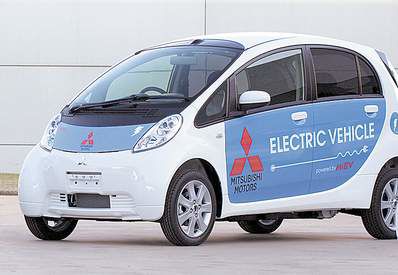Mitsubishi i-MiEV: an electric indulgence
Published 5:00 am Sunday, September 26, 2010

- The all-electric Mitsubishi i-MiEV is a bubble-shaped curiosity with bug-eyed headlamps. It takes too long to recharge to be practical transportation.
Mitsubishi is more than Mitsubishi Motors. It is a massive multinational conglomerate with businesses in nearly every aspect of human life, including elderly care.
But at its core, Mitsubishi is a research and engineering company. Over the past 35 years, it has spent billions of dollars and thousands of hours trying to come up with alternatives to the gasoline engine.
One result of those efforts is the all-electric i-MiEV urban car — a subcompact hatchback on sale in Japan with plans for a U.S. introduction in fall 2011.
The “innovative-Mitsubishi electric vehicle” draws upon many of the company’s competencies, including those in electronics, environmental research and small-car development. But whether it will draw buyers in the United States, a country long hostile to small cars and suspicious of automobiles lacking gasoline engines, is another matter.
In Japan, Mitsubishi is relying on the government to help make the trademarked i-MiEV a success. Authorities there are installing quick-charge stations, 167 so far, around the country. That speaks to the crucial issue of infrastructure, vital to consumer acceptance of any technology for personal mobility.
Quick-charge stations can deliver an 80 percent recharge of the i-MiEV’s lithium-ion battery pack in 20 minutes. A full recharge takes an hour.
Otherwise, recharging must be done the old-fashioned way — plugging into a 110-volt outlet (12 to 14 hours for full recharge), or a 220-volt outlet (six to eight hours). I did it at my Virginia home the old way, which highlighted two potential problems for U.S. consumer acceptability of the i-MiEV.
Patience and planning
Rare is the American consumer who is willing to wait six to 14 hours to fully recharge anything, including a cellphone, laptop, iPad — or i-MiEV. Quick-charge stations similar to those being put in place in Japan are mandatory for the U.S.-market success of the i-MiEV — or any rival all-electric car, including the upcoming Chevrolet Volt and Nissan Leaf.
At the very least, there must be agreement and compatibility on home-charging technology. For example, in anticipation of driving more electric vehicles, I installed a 220-volt outside charging port at my home 11 years ago. It worked for the now-discontinued General Motors EV1. It worked for several other all-electric vehicles. But it’s too big for the male head of the i-MiEV’s charging cable.
So, I plugged into the 115-volt outlet … and waited, which highlighted other concerns.
The first is that the i-MiEV, which can get 50 to 80 miles per charge depending on driving style and conditions, is the perfect second or third car. But it’s a lousy only car, especially for people who are allergic to planning or who regularly require long road trips to earn a living or just to stay happy.
Owning and using the i-MiEV means planning ahead and seriously thinking about energy use while driving. That means routinely plugging into your home outlet, or some other available outlet, when parked for at least six hours. It also means a more judicious use of onboard amenities and a more judicious selection of driving conditions.
For example, do you really need to run that heater or air conditioner? Doing so reduces battery charge and driving range.
Or it’s windy and rainy outside. Do you really need to make that trip to the shopping center? High winds mean increased wind resistance for your i-MiEV, or any other car, which means using extra effort and power to overcome that resistance. This is OK if you’re in a gasoline-fueled vehicle with gas stations on every other corner, but not so OK if you are in a limited-range all-electric vehicle with no quick-charge stations anywhere.
Whether it takes 20 minutes or 14 hours, the electricity to power up the i-MiEV comes from somewhere. And I have some friends in West Virginia living near mountains stripped of coal and beauty who can tell you from whence it comes.
Ride, acceleration and handling: Ride is pleasant on good roads, but horribly bumpy on poorly maintained streets. You can run well with this one within all posted speed limits (up to 81 mph maximum). Just keep in mind that the faster you go, the shorter your driving range. Handling is small-car acceptable.
Body style/layout: The Mitsubishi i-MiEV shares the same platform with the gasoline-fueled Mitsubishi i-minicar, which means it is rear-wheel drive with the propulsion system in the middle — behind the front steering wheels and just ahead of the rear drive axle.
Capacities: There are seats for four people. It can carry up to four bags of groceries. Caution: Driving range decreases as onboard weight increases.
Safety: The i-MiEV primarily is designed as a neighborhood/urban car. Because it has a maximum speed of 81 mph, the U.S. version will come with the required front air bags and outboard seat belts front and rear. According to first-response officials nationwide, revised emergency procedures must be established to handle crashes of electric vehicles.
Price: Mitsubishi hopes to introduce the i-MiEV in the United States in fall 2011 at a base price below $30,000 before government subsidies, which, if provided, would lower that price.
Bottom line: Electric vehicles will be an important part of our driving future. But they will play second fiddle to the gasoline engine, especially in the United States, for years to come. But automobile manufacturers who make the mistake of thinking they can back away from electrics today will wind up playing second fiddle to Mitsubishi tomorrow.
2010 Mitsubishi i-MiEV urban car
Base price: below $30,000
Type: Subcompact hatchback
Engine: The propulsion system consists of a 300-volt lithium-ion battery pack and a permanent magnet synchronous motor with the performance equivalent of 63 horsepower and 133 foot-pounds of torque.
Mileage: All-electric with a range of 50-80 miles per charge







